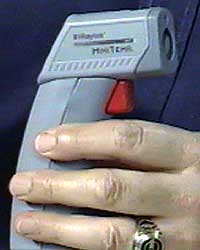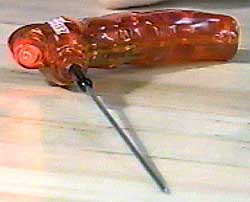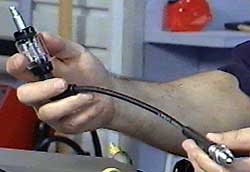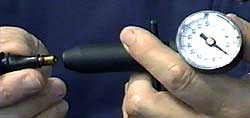Pat’s Cool Tools
 This time I have a couple of tricks for both professional technicians and do-it-yourselfers. One of the big problems that we face in the automobile industry these days is when an engine misfires we have an absolute rhythmic misfire to the engine. Well, how do you go about testing that without some very expensive test equipment?
This time I have a couple of tricks for both professional technicians and do-it-yourselfers. One of the big problems that we face in the automobile industry these days is when an engine misfires we have an absolute rhythmic misfire to the engine. Well, how do you go about testing that without some very expensive test equipment?
Well, to begin with, we’ll use this Raytek digital thermometer from Griot’s Garage. All right, now what do we do with this? We warm the engine up, and it’s sitting there missing. We aim it at the exhaust manifold on each one of the cylinders. Go down the line. Do all four, six, or eight cylinders, and the one that is cold is the one that is missing.
 Okay, now, we have a misfire. We know which cylinder it is. But how do we determine if it’s a fuel problem or if it’s an ignition problem or something else? Well, the next tool is this EFI Quick Probe. Now, it’s a pretty ingenious little piece. It reacts to the vibrations that a fuel injector makes. So on the affected cylinder, you put the probe against the fuel injector, and if the injector is working, it will blink and beep, like that. If the injector isn’t working, no blink, no beep.
Okay, now, we have a misfire. We know which cylinder it is. But how do we determine if it’s a fuel problem or if it’s an ignition problem or something else? Well, the next tool is this EFI Quick Probe. Now, it’s a pretty ingenious little piece. It reacts to the vibrations that a fuel injector makes. So on the affected cylinder, you put the probe against the fuel injector, and if the injector is working, it will blink and beep, like that. If the injector isn’t working, no blink, no beep.
 All right, next thing. If the injector is working, now we need to see if we have high voltage spark to the spark plug. For that we need one of these very inexpensive spark testers. You unplug the spark plug wire and insert the tester into the end of the spark plug wire, and then connect the lead that comes with the tester back to the spark plug. Of course the plug would be in the engine. Crank the engine, and if it flashes, well, you have spark. If it doesn’t, you know that’s your problem and you pinpoint test the spark-producing components for that cylinder.
All right, next thing. If the injector is working, now we need to see if we have high voltage spark to the spark plug. For that we need one of these very inexpensive spark testers. You unplug the spark plug wire and insert the tester into the end of the spark plug wire, and then connect the lead that comes with the tester back to the spark plug. Of course the plug would be in the engine. Crank the engine, and if it flashes, well, you have spark. If it doesn’t, you know that’s your problem and you pinpoint test the spark-producing components for that cylinder.
 Well, here’s another big problem, trying to get a real accurate reading on tire pressure. If you’ve ever noticed, you take your pencil gauge and you push it against the valve stem. You get this whoosh of air coming out of there and you have to do it two or three times. You’re actually letting air out of the tire. Well, this is a valve lock tire gauge, and the way it works is very simple. When you put it over the valve stem, you pull this handle and it locks right onto the valve stem. No leakage, very accurate reading.
Well, here’s another big problem, trying to get a real accurate reading on tire pressure. If you’ve ever noticed, you take your pencil gauge and you push it against the valve stem. You get this whoosh of air coming out of there and you have to do it two or three times. You’re actually letting air out of the tire. Well, this is a valve lock tire gauge, and the way it works is very simple. When you put it over the valve stem, you pull this handle and it locks right onto the valve stem. No leakage, very accurate reading.
If you have a question or comment, write to me. The address is MotorWeek, Owings Mills, MD, 21117.





